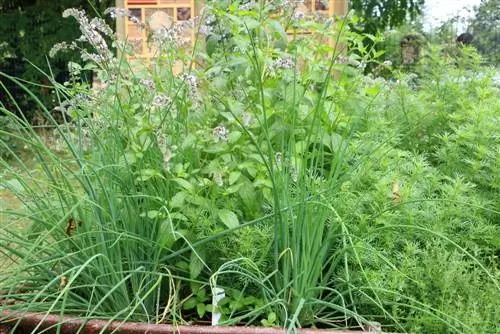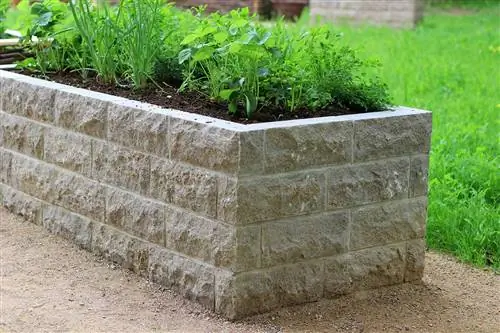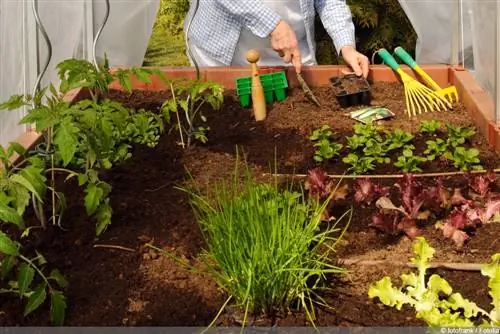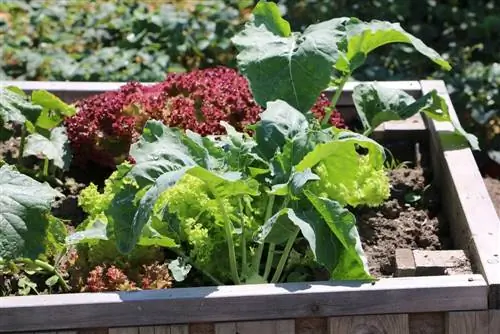- Author admin [email protected].
- Public 2023-12-17 03:39.
- Last modified 2025-01-24 12:45.
Using plants as borders gives your garden a clearly defined structure in a natural interpretation. A wide range of tried and tested species and varieties meet the high demands that home gardeners place on low-maintenance bed borders. Immerse yourself in a selection of suitable small shrubs, perennials and herbs that give your beds a picturesque frame with an architectural component.
Evergreen small shrubs
Shoot death and boxwood borers have dethroned the boxwood as a classic bed border. In order to frame ornamental and vegetable beds in an evergreen manner, the following small shrubs have emerged:
Barberry 'Nana' (Berberis buxifolia)
With its bushy, hemispherical habit, the barberry 'Nana' is a feast for the eyes that impressively sets off any flower and vegetable bed. Sharp spines and densely branched growth make the evergreen border a natural bulwark against uninvited cats and dogs. Gardeners do not need to fear confrontations with the prickly shoots, as the mini barberry requires neither pruning nor extensive care work.
- Growth height: 40 to 50 cm
- Special feature: orange-yellow flowers from May to June
Holly 'Heckenzwerg' (Ilex aquifolium)
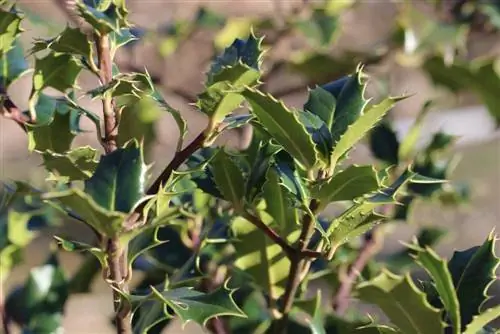
The thorny holly comes with all the attributes we want from the ideal boxwood alternative. The native deciduous tree is characterized by its compact growth, robust pruning tolerance and reliable winter hardiness.
- Growth height: 10 to 30 cm
- Special feature: evergreen with small teeth on the edges of the leaves
Rhododendron Bloombux (Rhododendron micranthum)
The innovative new breed is at the beginning of a great career as a magnificent alternative to boxwood. Bloombux delights with small, pointed leaves that are reminiscent of the foliage of Buxus. In June, the gem puts on a delicate pink flower dress from which a seductive scent emanates. In contrast to majestic rhododendrons, the dwarf variety tolerates cutting very well.
- Growth height: 50 to 60 cm
- Special feature: evergreen and lime-tolerant
Tip:
Rhododendron 'Bloombux' convincingly demonstrates its compatibility with cutting if you grab the scissors at the right time. The best time to cut is after the early summer flowering period. The opulent bed border is suitable for any creative topiary, from hemispherical to square or even in waves.
Shadow bell 'Cavatine' (Pieris japonica)
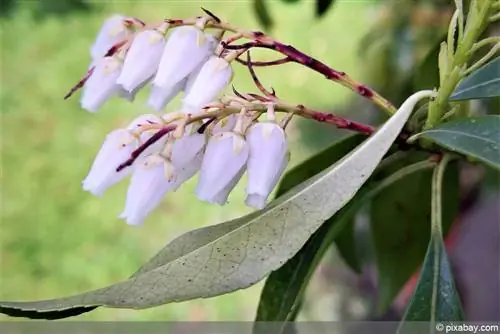
Look out for a shade-tolerant bed border here, please focus your attention on the shade bell. The pretty dwarf shrub grows evergreen, compact and rounded in shape. From March to April, elegantly overhanging flower panicles appear that do not care about the lack of light in the location. A light pruning after the flowering period cleans up wilted panicles and guarantees a well-groomed appearance for the rest of the season.
- Growth height: 40 to 50 cm
- Special feature: favors a wind-protected location
Holywort, olive herb (Santolina rosmarinifolia)
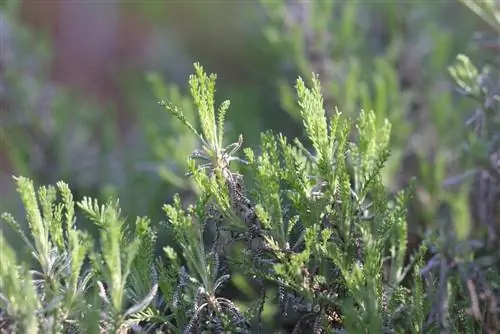
The aromatic, fragrant dwarf shrub is an insider tip among home gardeners for imaginative bed borders in sunny locations. From June to August, yellow flower heads rise above the lush green leaves and shine in competition with the summer sun. The uncomplicated pruning tolerance allows for extensive topiary pruning in spring, followed by light care pruning in summer to encourage a second round of flowers.
- Growth height: 30 to 50 cm
- Special feature: Light winter protection recommended in rough locations
Lavender heather 'Curly Red' (Leucothoe axillaris)
With bizarrely twisted, evergreen decorative leaves, lavender heather makes boxwood borders disappear into oblivion. The fresh green foliage color of summer takes on a reddish hue in autumn. Without a visible transition, the spiral leaves turn back into the promising green in spring. The eye-catching play of colors is complemented by delicate, white flowers from May to June.
- Growth height: 30 to 45 cm
- Special feature: thrives in sunny, partially shaded and shady locations
Perennials
The most important criterion for a perennial as a bed border is compact, clumpy growth without runners. Furthermore, the plants should have a dense root ball so that framed ornamental and vegetable plants do not spread underground into neighboring beds and paths. The following perennials also score points with their attractive foliage and colorful flowers:
Carnation 'Düsseldorfer Stolz' (Armeria maritima)

Carnations boast spherical flower heads from May to September as a bed border, accompanied by dense, grass-like leaves. There is no way for a lot of perennials, flowers and vegetable plants to get through here. Its penchant for sunny, sandy, lean locations makes the common thrush the ideal border plant for heather and rock gardens.
- Growth height: 30 to 40 cm
- Special feature: wintergreen to evergreen and reliably hardy
Pearl Basket (Anaphalis triplinervis)

Pearl baskets ennoble any garden as a distinctive border with a special charm. The white cup flowers shine above the silver-grey, lanceolate foliage from July to October. In addition to the subtle play of colors, a hemispherical, clump-like growth makes the undemanding perennial the perfect border for any natural garden.
- Growth height: 30 to 40 cm
- Special feature: well suited for dry bouquets
Porcelain flowers (Saxifraga urbium)
The valuable perennial is characterized by a combination of delicate flower beauty and dense rosettes of leaves that grow evergreen. The dark red stems on which the red and white flower panicles appear in May are striking. These properties make the porcelain flower a sought-after border for farm and natural gardens.
- Growth height: 10 to 30 cm
- Special feature: serves as a border for partially shaded to shady locations
Herbs
Since the Middle Ages, home gardeners have relied on the many benefits of herbs as borders. With dense growth and a spicy scent, herb plants ensure order and effectively contain the enclosed plants' urge to spread. A good-natured pruning tolerance reduces the maintenance effort to a minimum. Last but not least, ecologically oriented gardeners appreciate the pest-repellent effects of various species. The following premium herbs act as bed borders and biological plant protection at the same time:
Lavender 'Blue Cushion' and 'Cedar Blue' (Lavendula angustifolia)
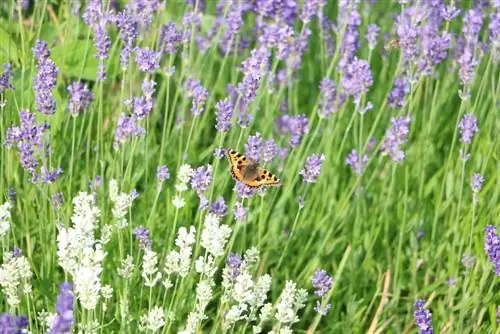
In the Mediterranean garden and in authentic cottage gardens, lavender has cult status as a bed border. The focus is on the two varieties 'Blue Cushion' and 'Cedar Blue', which impress with their low growth and dense branching. Where the two magnificent specimens present themselves as border plants, cunning aphids have a bad hand. Care is limited to watering when the summer is dry and pruning in early spring.
- Growth height: 40 to 50 cm
- Special feature: Summer remounting stimulates beautiful re-bloom
Tip:
Mediterranean herbs, such as lavender, show their most beautiful side as borders when there is no supplementary nutrient supply. Do not work humus into the soil when planting. Do not administer mineral or organic fertilizers such as blue grain, compost or horn shavings.
Thyme ‘Compactus’ (Thymus vulgaris)
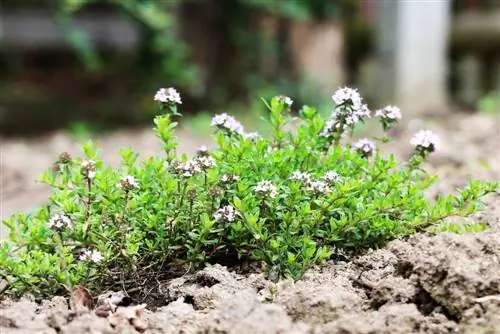
The thyme variety was discovered in a Dutch monastery garden, where it lay at the feet of perennials, flowers and vegetable plants with its spherical habit as a low bed border. The oval leaves are evergreen, which provides decorative accents in the dreary winter. From July to September, purple flowers rise above the pretty foliage, busily swarmed by bees, bumblebees and butterflies.
- Growth height: 5 to 10 cm
- Special feature: repels aphids
Sage (Salvia)
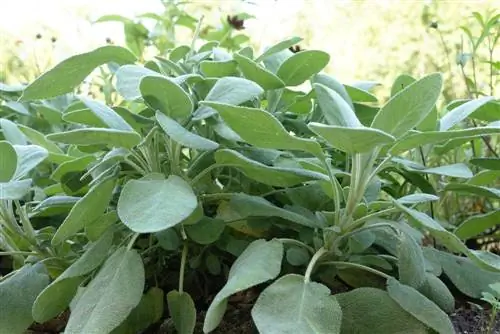
In the form of flowering sage (Salvia nemorosa) and spice sage (Salvia officinalis), the popular herb plant is often used as an idyllic or spicy border. If you primarily value a colorful border, we would like to recommend the 'Ostfriesland' variety to you. For a rich herb harvest, we recommend the tried and tested variety 'Tricolor', whose tasty leaves are colored green, white and violet-grey.
- Growth height: 30 to 40 cm
- Special feature: Used as a border to keep snails and caterpillars away
Chives (Allium schoenoprasum)
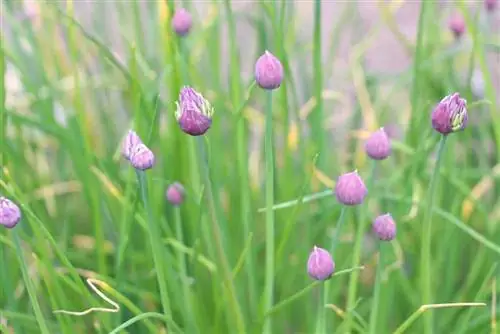
Chives provide convincing evidence that a simple culinary herb is perfect as a natural bed border. Planted close together, the herb plants form a decorative frame for the bed with summer flowers as the highlight. The kitchen is happy to receive a daily supply of fresh chive stalks, which add a delicious touch to cold and warm dishes.
- Growth height: 20 to 25 cm
- Special feature: Protects plants susceptible to powdery mildew from infection as a border border

